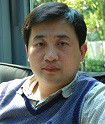王文龙
2021年08月13日更新

王文龙,男,1977年10月生。
中国科学院物理研究所,研究员,博士生导师。
国家优秀青年科学基金获得者。
电话:010-8264 8692
传真:010-8264 9228
邮箱:wwl@iphy.ac.cn
教育背景:
1995.09 - 1999.07 山东大学化学系 学士
1999.09 - 2004.07 中国科学院化学研究所 理学博士
专业:物理化学
工作履历:
2004.08 - 2006.07 中国科学院物理研究所 博士后
2006.08 - 2012.08 中国科学院物理研究所 助研/副研究员
2006.10 - 2008.03 日本国立材料科学研究所(NIMS) ICYS Research Fellow
2012.09 - 中国科学院物理研究所 研究员
研究方向与主要学术业绩:
主要研究方向为轻元素低维材料的化学与物理,研究兴趣包括C/B-N/B-C-N体系的纳米管材料与二维原子晶体材料,主要关注其控制合成、控制掺杂、电子结构调控、表面化学修饰、电输运与器件基础、光物理与光电性质、自旋态调控与磁性、以及与水分解过程相关的催化特性等。
研究注重化学与物理的交叉与融合,近十年来在轻元素低维纳米材料研究方面做出过多项有影响力的创新性工作,受到了本领域国际同行的肯定与重视。迄今已发表SCI论文50余篇,其中包括7篇J. Am. Chem. Soc.,4篇Adv. Mater.,3篇Nano Lett,1篇Nat. Nanotechnol.,1篇Nat. Commun.,论文被SCI他引600余次,有多篇学术论文被作为研究亮点进行报道以及被权威综述文章多次引用。
曾获中国科学院王宽诚博士后工作奖励基金(2005年度)、北京市科学技术奖一等奖(2008年度)。
2013年获国家优秀青年科学基金。
Academic Biography
Wenlong Wang received his B.S. in chemistry in 1999 from Shandong University. In 2004 he earned a Ph.D. in physical chemistry from Institute of Chemistry, Chinese Academy of Sciences (CAS) where his graduate research focused on the colloidal semiconductor nanocrystals and the self-assembled molecular films. After that, he joined the group of Prof. Enge Wang at Institute of Physics CAS to undertake postdoctoral research. In 2006, he was appointed as an assistant and then associate professor of Institute of Physics. From 2006 to 2008, he has been working as a visiting scholar at International Center for Young Scientists (ICYS), National Institute for Materials Science (NIMS), Japan. In 2013, he was promoted to a full professor of Institute of Physics.
The area of research of Prof. Wenlong Wang lies at the interface of physics, chemistry and nanoscience. His current research efforts revolve around the light-element based nanostructures and materials, with primary interests in carbon nanotubes, graphene and their BN and B-C-N analogues, concerning their controlled synthesis, substitutional doping, chemical functionalization, electronic structure engineering, electrical transport properties, photophysics and optoelectronic properties, spin polarization and collective magnetism. Ongoing research work also involves exploring the perspective applications of light-element nanomaterials and their composites for fostering innovative solutions to the environmental and energy challenges.


